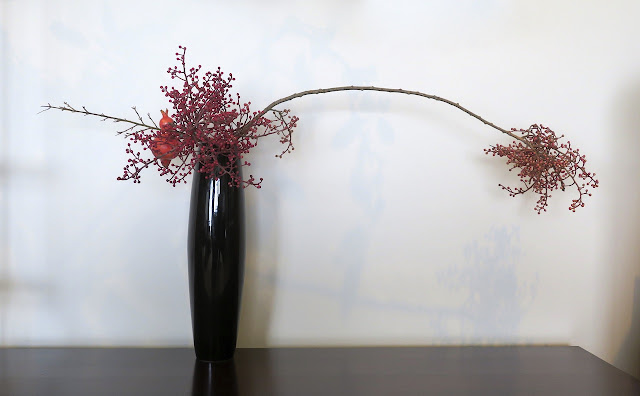At my Torquay class last week I had set an exercise requiring the students to use two vessels in which to create their ikebana and to incorporate some 'unconventional' (man made) material. This class includes some new students, so it was a considerable challenge. The photos are of the ikebana works with adjustments made following my critique.
The two particular difficulties in the exercise are to make a unified work in which both vessels play a part. The second is that the unconventional materials are essential to the design such that the ikebana would look incomplete if they were removed.
Jean used two white vessels of different shapes. Her unconventional material is metal strapping that is used to stabilise walls that are made in wooden-framed houses. The botanical material is seaweed.
Marta has also used two non-matching white vessels. The unconventional material is rubberised netting that on the left side is wrapped around bamboo. The botanical materials are dark maroon succulent, Aeonium "Zwartkop".
Marian also used Aeonium, though a different and more commonly seen variety. She said the succulents made her think of Mexican desert scenes, which influenced her in the choice of vessels and the bright coloured unconventional materials.
Judith used a black ceramic stand and a dark metal urn-shaped vessel. Her unconventional material is a black net string-bag supported on a length of bamboo. The botanical materials are Aeonium, and leaves of a variegated Dracaena, probably D. fragrans 'Lemon Lime'.
In the garden, as we come to the end of Autumn, there are a few exotic plants with colourful leaves that I thought I could include in this weeks ikebana.
The first is on one of the Hydrangeas. I successfully struck two cuttings of this plant, undoubtedly H. macrophylla, however I do not know which variety.
The leaves on the apricot tree are a lovely yellow especially with the sun coming through them this afternoon. However they are very limp and fall easily from the branch when being arranged.
This leaf is from the self-sown apple, more of a bush than a tree. It struggles to exist as it is underneath the apricot and only about 20cm from its large trunk. The colours are delightful and the leaf attachment to the branch is more robust than the apricot.
The ikebana I created this morning features a large Hydrangea flower, from Rosemary and David's garden. Here on the coast were it is exposed to more harsh conditions the autumn colour is much darker than its parent.
I have set the single flowerhead to the left front and a long branch from the apple to the right. The leaves graduate from green through yellow and orange to a deep maroon. In the centre is a rich, orange-tipped leaf of the Hydrangea.
The ceramic vase is by the Katherine (Northern Territory) based artist Dan Murphy. I was introduced to his work by Ray Bywaters, when I presented workshops to the South Australian Sogetsu Branch earlier this year. I would also recommend this article about Dan Murphy from the ABC.
Greetings from Christopher
30th May 2021








































